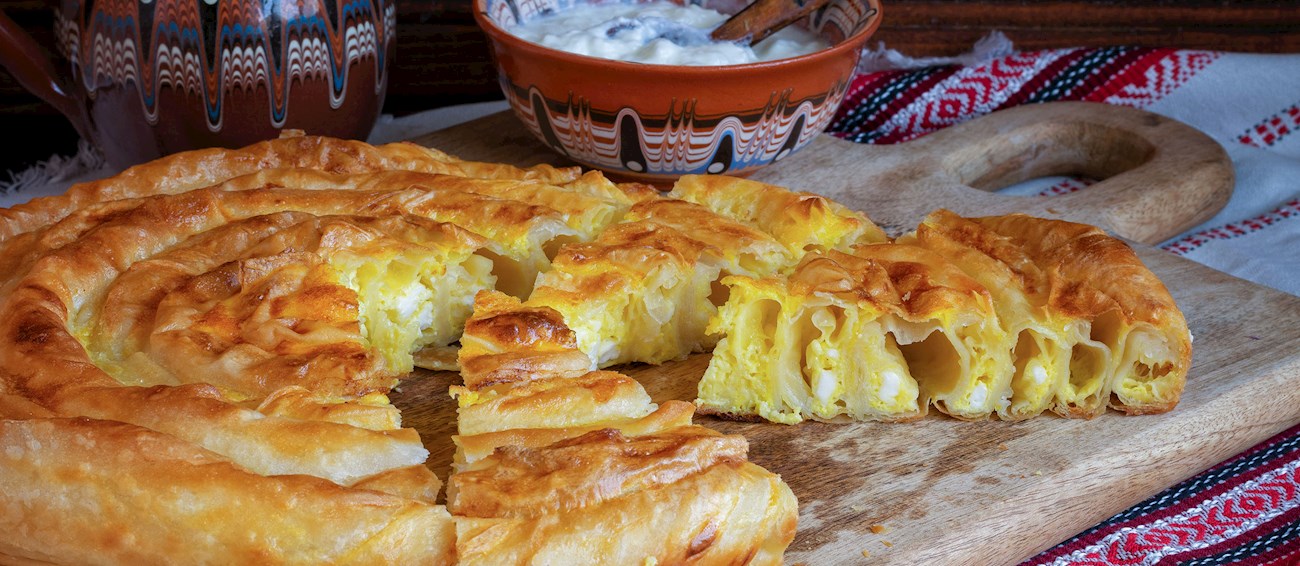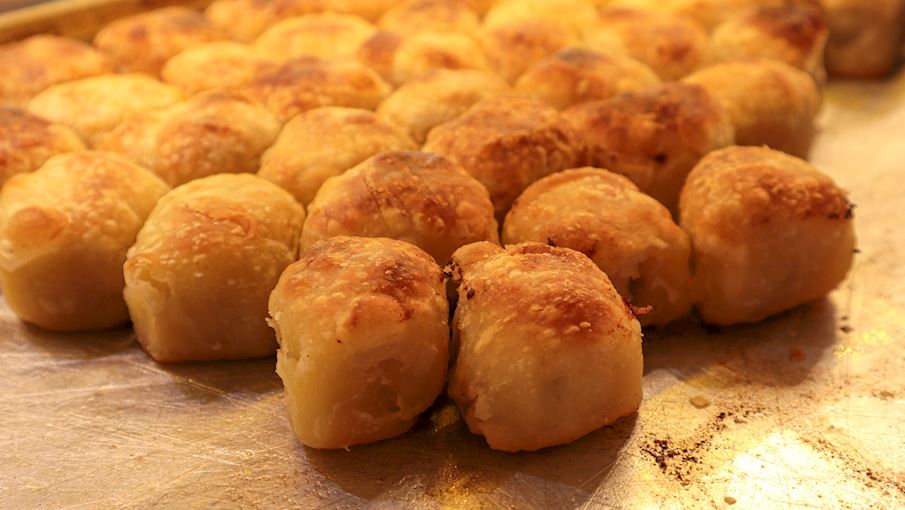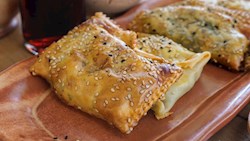Pazarske mantije is a Serbian dish originating from Novi Pazar. This dish resembles the Bosnian burek in flavor, but the shape is quite different – it's shaped into small spheres that are arranged in a baking pan and baked together.
The dough is first stretched, brushed with butter, then stuffed with ground beef, salt, pepper, onions, and a bit of oil. Once stuffed, the dough is shaped into small balls, arranged in a pan, then baked, traditionally in old furnaces which give them their unique flavor and aroma.
Mantije are usually accompanied by yogurt that's poured over them and eaten while still hot.
MAIN INGREDIENTS
The Bulgarian pie banitsa made with cheese is the main version of this traditional pie. It's made by layering sheets of buttered phyllo pastry with a combination of eggs, yogurt, and cheese such as sirene and feta. There's an optional ingredient in the preparation of banitsa and it's baking soda, which makes the yogurt rise and makes the pie fluffier and richer in flavor.
Traditionally, banitsa with cheese was prepared and served on Christmas and New Year's Eve, but nowadays it can also be bought throughout the year at grocery stores, street vendors, kiosks, and pretty much everywhere. Apart from this basic variety, there are also other types of savory or sweet banitsa pies filled with various vegetables and fruits.
Karipap or curry puff is a small, deep-fried or baked pastry shell filled with thick chicken and potatoes curry. It is believed that the flavorful snack was invented by the Malays from the Malay Peninsula and parts of Sumatra and Borneo.
It is a popular breakfast item or an afternoon snack which can be found at numerous stores, bars, and markets. Because of its simplicity and flavor, karipap quickly became popular outside Malaysia, especially in Thailand and Singapore. Today there are numerous versions of karipap, so instead of potato and chicken curry, it can be filled with various other ingredients such as tuna, sardines, and beef rendang.
MOST ICONIC Karipap
View moreMAIN INGREDIENTS
Zelnik is a traditional North Macedonian pie that can be filled with a variety of different ingredients such as cheese, spinach, eggs, meat, leeks, or cabbage. For the best result, zelnik should be brushed with butter and oil before baking, so that the pie develops a golden-brown color.
Zelnik is best when served warm, and it is recommended to pair it with a glass of yogurt.
MAIN INGREDIENTS
Burek consists of layers of phyllo dough stuffed with various savory fillings. Despite its Turkish origins, this dish has evolved into a proud gem of Bosnian national cuisine. Although most locals claim that only burek with ground beef can be called burek, the same dish also appears with other fillings, and these other varieties are known by different names: sirnica (cottage cheese), zeljanica (spinach), and krompiruša (potatoes).
Burek is baked rolled into a snail-like shape and this type is typically found in bakeries, while traditional restaurants often make it in the form of a pie, which is sliced into quarters before serving. The dish is wildly popular all across the Balkans, though in Bosnia and Herzegovina, the cultural significance of this everyday staple is incomparable and best summed up in a number of local proverbs suggesting that if a woman can make a good burek, she's eligible for marriage.
MOST ICONIC Burek
View moreMAIN INGREDIENTS
Tiropita is a popular Greek snack consisting of sheets of phyllo dough that are filled with a combination of cheese (usually feta) and eggs. The dish is typically wrapped in triangular pieces and brushed with melted butter before baking. This tasty pastry is found in almost every Greek bakery, although it is commonly served as an appetizer, when it is accompanied by numerous dips on the side.
There are several theories about its origin, but most link the dish with either Byzantine, Roman, or Turkish cuisine. Tiropita is mostly consumed in the mid-morning in Greece, since breakfast is usually reserved only for bread with butter and a cup of coffee.
VARIATIONS OF Tiropita
One of the most common fast food items in Brazil is known as pastel, a deep-fried, stuffed pastry. This half-circle or rectangle-shaped miniature pie is stuffed with a variety of ingredients, most commonly shredded chicken, ground beef, mozzarella, or small shrimps.
Sweet varieties also exist, and they are usually made with chocolate, bananas, or guava jam, but they are not as common as their savory counterparts. The exact origin of the dish is not familiar, but it is believed that pastel evolved from the Chinese spring roll, which was brought to Brazil by Japanese immigrants.
MOST ICONIC Pastel
View moreMAIN INGREDIENTS
Burek sa sirom is a phyllo pastry that is round or coil-shaped and filled with a mixture of cheese and eggs. The dough is made with flour, salt, and water (and perhaps a bit of oil) and stretched into translucent sheets. The sheets of phyllo dough are stacked in a large tray, and each sheet is sprinkled with oil or oil and mineral water and spread with the cheese and egg filling.
Still, you might have heard that burek can only be called burek if it's filled with meat. That is, if you live in Bosnia and Herzegovina, but not everyone does, nor is burek really Bosnian – in fact, it has Turkish origins. In Bosnia, burek (with meat) and other types of similar pies such as sirnica (cheese) and krumpiruša (potatoes) are usually rolled into a coil, while Croatians and Serbs have a more relaxed approach – burek can be round and cut into quarters, or rolled into a coil – both shapes are good, and both can be called burek sa sirom (when filled with cheese, of course).
MOST ICONIC Burek sa sirom
View moreMAIN INGREDIENTS
This delectable cheese-filled focaccia hails from the town of Recco, Liguria's gastronomic capital where it can be found in every bakery, pizzeria, and restaurant. It was reportedly invented in the 12th century when, according to legend, the citizens of Recco were preparing this dish for the Crusaders with the little they had: flour, water, olive oil, and some cheese.
Unlike most other focaccia flatbreads, this one is made without yeast, and features a paper-thin, hand-pulled crust filled with the soft, mild-flavored cow’s milk cheese from Alpine pastures called stracchino or crescenza. By the end of the 1800s, focaccia di Recco had become traditionally associated with the celebration of All Saints' Day, but today it is prepared and enjoyed throughout the year.
MOST ICONIC Focaccia di Recco col formaggio
View moreMAIN INGREDIENTS
Paçanga böreği is a Turkish börek variety that's especially popular in the region of Anatolia and in Istanbul, where it's regarded as a traditional Sephardic Jewish specialty of the city. It's made by stuffing yufka or phyllo pastry with pastirma (salted, aged, dried beef) and kasar cheese.
Apart from the basic ingredients, some people also like to add peppers and tomatoes to the filling. The dough is rolled, cut into rectangles, then fried. This börek can also be baked, but frying is the traditional method. Paçanga böreği is served hot and it's typically eaten as an appetizer.
TasteAtlas food rankings are based on the ratings of the TasteAtlas audience, with a series of mechanisms that recognize real users and that ignore bot, nationalist or local patriotic ratings, and give additional value to the ratings of users that the system recognizes as knowledgeable. For the “Top 100 Savory Pastries in the World” list until February 13, 2025, 9,424 ratings were recorded, of which 5,023 were recognized by the system as legitimate. TasteAtlas Rankings should not be seen as the final global conclusion about food. Their purpose is to promote excellent local foods, instill pride in traditional dishes, and arouse curiosity about dishes you haven’t tried.














































































































































